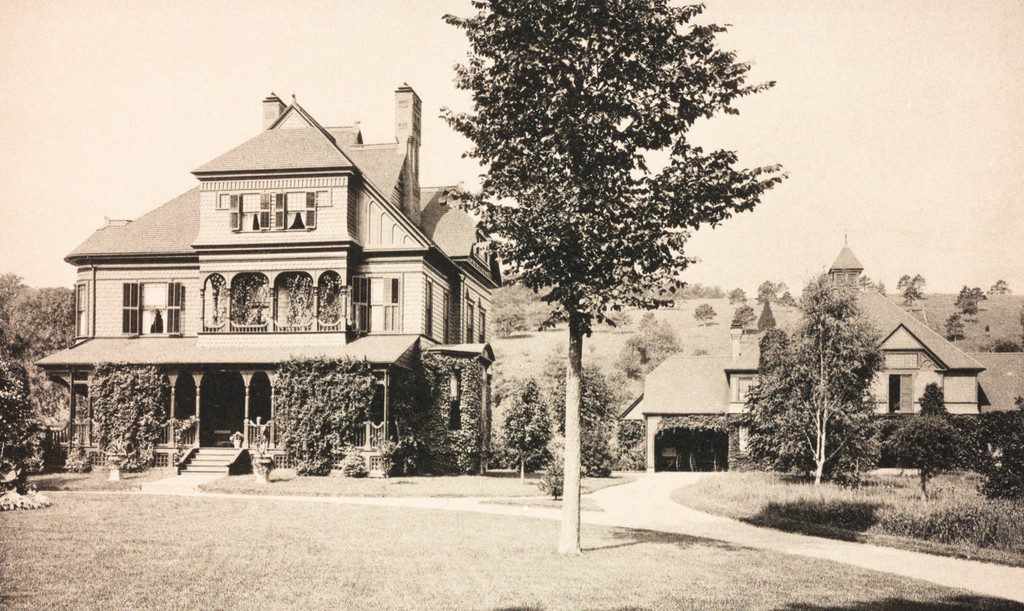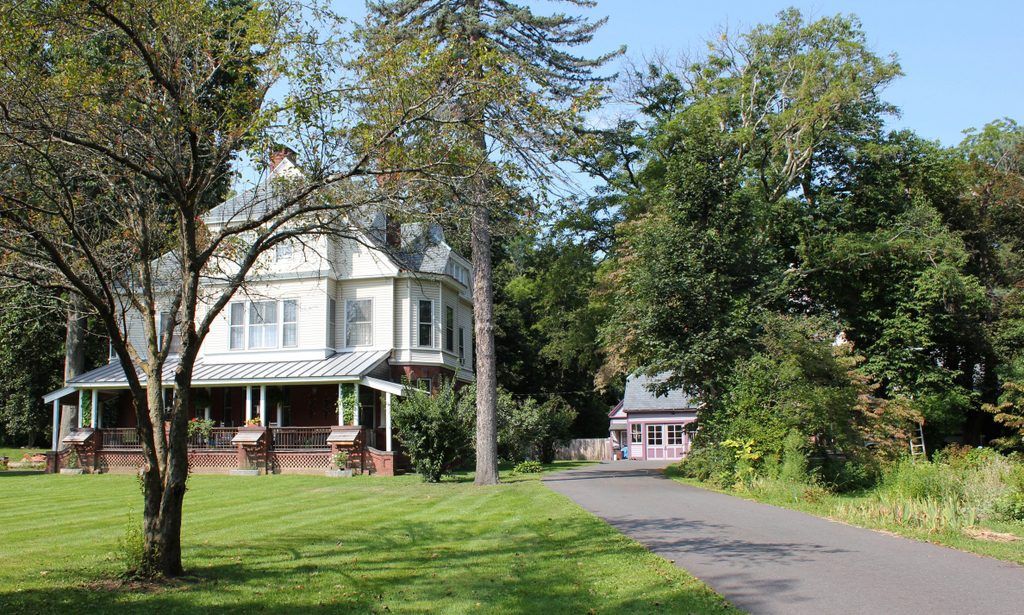The house at 1425 Northampton Street in Holyoke, around 1891. Image from Holyoke Illustrated (1891).
The house in 2017:
This large Queen Anne-style house was built in 1884, and was the home of Robert B. Johnson, a prominent insurance agent and bank executive. Johnson was born in 1828 in East Weare, New Hampshire, but he later came to Holyoke. He established the R. B. Johnson & Son insurance agency, which offered fire, life, and accident insurance out of its offices on High Street, and he was also involved in both the Holyoke Savings Bank and the Holyoke National Bank. From 1866 until his death in 1899, Johnson was the treasurer of the savings bank, and he was also the first vice president of the national bank, starting in 1872. He eventually became president of the bank in 1896, and served in that role until his death three years later.
Robert Johnson lived here in this house with his wife Cornelia and their two children, Charles and Jenta. Charles joined his father in the insurance and banking businesses, eventually succeeding Robert as treasurer of the Holyoke Savings Bank, and he lived here in this house until around the time of his marriage in 1890. Two years later, he built a house of his own, which was located just south of his father’s house at 1439 Northampton Street. Then, in 1893 his sister Jenta married businessman George C. Gill, and the couple lived here in this house with Robert and Cornelia.
The 1900 census, taken a year after Robert’s death, lists Cornelia living here along with Jenta, George, and their two daughters, Dorothy and Dorcas. The family also employed four servants, who also lived here in the house. Until 1899, he was the president of the George C. Gill Paper Company, and he later became vice president of the American Writing Paper Company, after the company acquired the Gill company. He resigned the position in 1902 in order to become president of the Holyoke National Bank, and over the years he also served as president of the Missisquoi Pulp and Paper Company, the Erving Paper Mills, and the Holyoke Heater Company.
Cornelia Johnson died in 1914, and her daughter Jenta in 1923. However, George Gill outlived his late wife by many years. During the 1930 census he was living here with Dorcas and her husband, Lincoln B. Smith, who worked under Gill as the assistant treasurer of the Holyoke Heater Company. A decade later, Lincoln and Dorcas had two young children, Robert and Virginia, and they were still living here with George Gill. By this point, Lincoln was Vice President of the Holyoke Heater Company, with the 1940 census listingjisbannual salary as $4,000, but he subsequently became a sales representative for the Haven Paper Company.
George Gill went on to live in this house until his death in 1955, at the age of 97. Lincoln and Dorcas moved out at around the same time, and at some point around the mid-20th century the exterior of the house was altered. This included replacing the exterior wood with siding, and enclosing the second-floor porch. These changes resulted in the loss of many of the home’s Victorian-era ornamentation, but otherwise the house is still standing. The carriage house, visible further in the distance on the right side of both photos, is also still there, and its exterior has actually been better-preserved than the house itself.



The siding was done by my father, James Occhiuzzo, n the late 1980’s. This was done so that the original wood shingle siding could be preserved underneath. My father also updated the heating system from the old steam to baseboard hot-water, but utilizing the original steam radiators to preserve those as well. You may want to verify History before filling in blanks with creative writing…
What exactly was incorrect about what I wrote, other than my estimate of when the siding was put on? Whether or not the original wood is still somewhere underneath the modern siding, there are still plenty of details that are completely lost, especially the porches.
You never mentioned the nursing home, Downey Side, the fire, the restoration, etc. The lost details pale in comparison to what has actually been preserved. Have you been inside? Hand carved staircases and fireplaces, painted ceilings and leather inlaid in the walls, Double Irish Chain hand made parkay wood floors, stained glass windows and a butlers pantry. Don’t get me wrong, it’s not a bad piece- but you stopped your research when things were getting interesting.
I agree with you. Who cares that the modern siding was put on with “care”… siding being put on is never a positive thing with historic homes. I think you did a FANTASTIC job on this essay. I love this post.
Banker Robert Bruce Johnson, my maternal great-grandfather, built the house and barn/carriage house in 1871-73. They built the barn first and lived there in an upstairs apartment until the house was finished. It was located on 19 acres of land stretching vertically up the hill to the Easthampton Road to what is now Lindor Heights. The daughter of Lincoln and Dorcas Gill Smith, I was the fourth generation to live in the house. My parents sold the house and the property up to the top of the hill in 1954. They kept the hill-top portion and developed it into the Lindor (a contraction of Lincoln-Dorcas) subdivision. They built the house at 10 Lindor Heights (nearest the Easthampton Road) for themselves in 1958.
The Highlands area was being newly developed when Robert and Cornelia Clark Johnson bought the property. The original address was 208 Northampton Street. I don’t know when it became 1425. The next-door neighbor (to the north) was George C. Prentiss, head of the Prentiss Wire Company. When my great-uncle Charlie was married to Cora Ashley, Robert gave him a portion (an acre?) of land on the south side to build his home on. This is 1439 Northampton Street. Both houses are still standing today as opposed to the Prentiss house which was torn down to build small individual houses.
Our house had four floors: cellar, first and second floors, and the top floor contained two storage rooms as well as two bedrooms for a maid and cook, a central large playroom, and a bath. There were 6 bathrooms, and five fireplaces (3 on the first floor and 2 on the second floor). Depending on how you count them, as several rooms merged into each other, there were anywhere from 23-27 rooms with multiple pantries. The artwork on the ceiling of the dining room alluded to the family colonial history of the Johnsons who came to the Colonies from Wales in 1637 and settled in the seacoast area of New Hampshire (around Hampton) in 1639. Robert was born in Weare, NH; Cornelia’s family settled in the New Haven area of Connecticut around the same time.
When I was growing up in the1940’s we had two Jersey dairy cows, sheep (I still have the blankets made from their wool), chickens, and geese and ducks on the pond (Gill’s Pond). Robert loved trees and had two of many varieties (some unusual) on the property. During the 1938 hurricane, we lost 88 trees, and were still using the firewood when the house was sold in 1954. There were two large vegetable garden plots at the base of the hill, and I remember picking strawberries and eating them on the spot. There were grape vines and an apple orchard half-way up the hill (I-91 today). I remember my mother saying that’s where the horses were buried.
The rear of the house was an addition which contained a back kitchen, two bedrooms (a nursery and nursemaid’s room), and bath. I’m guessing the addition was built in the 1890’s when Jenta’s two daughters, Dorothy and Dorcas, were born. Robert and Cornelia Johnson and Jenta and George C. Gill are buried in Forestdale Cemetery in Holyoke. My parents. Lincoln and Dorcas Gill Smith are buried in Evergreen Cemetery in South Hadley with my paternal grandparents, Fred M. and Evelyn Bardwell Smith. I still have some of the original furniture from 1425. Memories!
Hi Ginny!!! This is Lynda Castle Wilson (Dots granddaughter) – I was just trying to put our family history in “easy to read form” for my kids and came upon thisInteresting facts – thanks! Do you know if George Gill died at this house -I see he is buried in Holyoke but my brother seems to think he died in Rochester? Thanks Ginny.
Hello,
My Grandparents – Marc & Cecile Barthello – purchased this property to then use it as a Rest Home. I do not know what year, do you have any knowledge of that? To my knowledge they did not do any renovations. I spent most summers there with my cousins who live locally. Grandpa & Grandma lived in the attic apartment which was quite large and lots of natural light.
In the late 1960’s or early 70’s my grandparents renovated the carriage house & moved into it. The main home was sold around this time. Renovations of the carriage house/barn included demolition of the wood structure that served as housing for horses & cows. The “chicken coop” was always a place that could serve as a guest house. There was a in ground swimming pool (crudely structured without a pumping system). I had a bad accident in that pool when it was empty.
I took so many pictures over the years but they have been lost due to so many moves as a military kid.
In short I would love to know more.